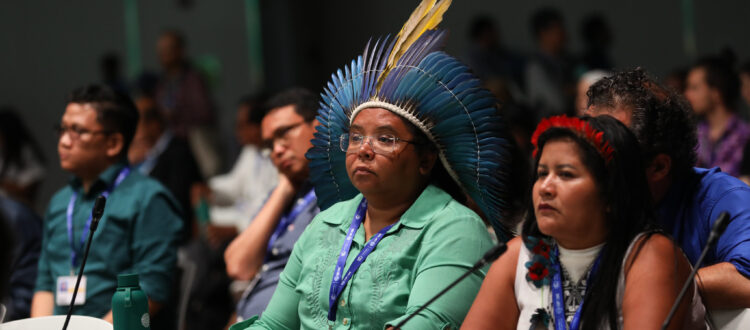COP28 AND INDIGENOUS POPULATIONS: LET’S TAKE STOCK
- Indigenous populations are among the most vulnerable to climate change and also suffer the predatory action of big corporations.
- The texts negotiated at COP28 still leave many challenges and questions open regarding the role of indigenous populations and their vulnerability.
- Overall, COP28 has left indigenous peoples on the sidelines and reflects the failure of coherent work across the various strands of work under the United Nations.
Indigenous populations and local communities around the world have for years been victims of the irresponsible conduct of many companies and, due to the complicity of their governments, also subjected to forced evictions, violation of land rights and non-observance of the so-called “free, prior and informed consensus”.
As in the case of the Kichwa community of Sarayaku, in the Ecuadorian Amazon, where in 2012 the Inter-American Court of Human Rights condemned Ecuador for having sold indigenous lands to a well-known Argentine oil & gas company, putting biodiversity and the local economy at risk, but also violating the cultural and religious rights of the Sarayaku population. And that of the Kichwa natives is unfortunately not an isolated case.
Studies also say that indigenous communities are also those most affected by the consequences of climate change. And according to Focsiv in 2020 alone, 331 indigenous leaders were killed for opposing devastation and pollution. However, indigenous populations, despite representing only 5% of the world population, are custodians of 80% of the earth’s biodiversity thanks to their wealth of knowledge (so-called indigenous knowledge) and their spiritual relationship with nature and their lands.
December 5th at COP was the thematic day dedicated to indigenous populations from all over the world, of which a particular presence was also noted among side events, initiatives both in the negotiation area (Blue Zone) and in the Ex Expo space open to visitors (Green Zone). Numerous associations participated as “formal observers” during the negotiation meetings.
Although the Loss and Damage Fund was adopted at the beginning of the negotiations, there are many ongoing challenges and open questions regarding indigenous populations. They are the following:
- Financial support is not enough. The money so far committed to the Loss and Damage Fund is an insignificant amount compared to the climate disaster costs facing indigenous peoples and local communities around the world. Furthermore, it will be necessary to see whether the commitments will translate into real allocations or whether they will remain voluntary as at present.
- The gender perspective is not yet intersectional. The discussions that took place in the ‘gender and climate change’ area, linked to the Lima Work Program on Gender and the Gender Action Plan aimed at integrating gender considerations into climate action as well as dictating objectives and concrete action strategies on climate justice, leave women indigenous back. Despite much disappointment on the part of the Parties, consensus was not reached to include specific mention of indigenous women and women of local communities. This approach does not take into account the role that indigenous women, custodians of ancestral knowledge, could play in the fight against climate change (we talked about it here).
- Once the moratorium proposal has fallen, clear constraints remain absent for big corporations regarding the prior implementation of safeguarding, governance and complaint mechanisms in compliance with the obligations of mitigation and protection of human rights, necessary to prevent that the projects carried out under Article 6 regarding the carbon market are ineffective and harmful to the rights of indigenous populations (we talked about it here). At the moment, the texts of Article 6.2 and Article 6.4 are lacking on this point. Furthermore, Article 6.4 in paragraph 21 does not include a specific mention of Traditional Indigenous Knowledge next to ‘best available science’.
- Positive, however, is the mention of indigenous populations and the valorization of their knowledge in the latest draft on Global Stocktake. And, specifically, in reference to effective consultation and engagement for the realization of a just transition: to “design, evaluate and implement adaptation processes and actions aimed at reducing the risks deriving from climate change”.
In general, it must be said that in this COP28 indigenous populations seem to have been left on the sidelines of the debate, despite the intense work of the relevant constituency and despite the recognition of their central role at COP15 on Biodiversity. An aspect that highlights how we still continue to work in separate compartments, rather than through concerted and coherent actions, even under the United Nations itself.
Finally, it is interesting to note that in conjunction with COP, the Global Indigenous People’s Climate Justice Forum launched an “Indigenous Impact Accelerator” in Dubai with the aim of supporting the entrepreneurship of young indigenous people. The project will give voice to the talent and ancient knowledge of many natives of indigenous communities from all over the world.
Martina Rogato, COP28 ICN Delegate and Co-chair Women
Erika Moranduzzo, Human Rights Expert and Coordinator of the ICN ‘Rights and Climate’ Section
Cover image: UNFCCC photo

